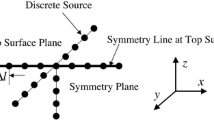Abstract
A general parameterization for inverse analysis of heat deposition processes using incomplete or minimal experimental data is presented. This parameterization is considered general in the sense that it can be applied, in principle, to the inverse analysis of a wide range of different types of heat deposition processes, including welding. The structure of this parameterization follows from the concepts of model and data spaces that imply the existence of an optimal parametric representation for a given class of inverse problems. Accordingly, the corresponding optimal parametric representation lies in the model space and is determined by the characteristics of the available data sets spanning the data space and the nature of the data sampling for purposes of parameter determination via appropriate optimization techniques. The elements of the proof presented here provide an elucidation of certain aspects of inverse heat-deposition analysis that are important for practical application.




Similar content being viewed by others
References
F. Darema, Introduction to the ICCS2006 Workshop on Dynamic Data Driven Applications Systems. Int. Conf. Comput. Sci., 3, 375–383, 2006
F. Darema, Dynamic Data Driven Applications Systems: New Capabilities for Application Simulations and Measurements. Int. Conf. Comput. Sci., 2, 610–615, 2005
J. Michopoulos, S. Lambrakos, On the Fundamental Tautology of Validating Data-Driven Models and Simulations. Int. Conf. Comput. Sci, 2, 738–745, 2005
J.G. Michopoulos and S.G. Lambrakos, Underling issues associated with Validation and Verification of Dynamic Data Driven Simulation, Proceedings of the 2006 Winter Simulation Conference, L.F. Perrone, F.P. Wieland, J. Liu, B.G. Lawson, D.M. Nicol, and R. M. Fujimoto, Eds. WSC, 2006, p 2093–2100
J. Xie, J. Zou, Numerical Reconstruction of Heat Fluxes. SIAM J. Num. Anal. 43(4), 1504–1535, 2005
S.G. Lambrakos and J.O. Milewski, “Analysis of Welding and Heat Deposition Processes using an Inverse-Problem Approach,” Mathematical Modelling of Weld Phenomena, 7, Verlag der Technischen Universite Graz, Austria, 2005, p 1025–1056
P.G. Moore, H.N. Jones III, S.G. Lambrakos An Inverse Heat Transfer Model of Thermal Degradation within Multifunctional Tensioned Cable Structures. J. Mater. Eng. Perform., 2005, 14(1), 112–118
S.G. Lambrakos, J.O. Milewski, Analysis of Processes Involving Heat Deposition using Constrained Optimization. Sci. Technol. Welding Joining, 2002, 7(3), 137–148
S.G. Lambrakos, E.A. Metzbower, J.O. Milewski, G. Lewis, R. Dixon, D. Korzekwa: Simulation of Deep penetration Welding Processes using Geometric Constraints based on Experimental information. J. Mater. Eng. Perform., 1994, 3(5), 639–648
J. Hadamard, Sur les problèmes aux dérivées partielles et leur signification physique, Princeton University Bulletin, 1902, p 49–52
D.N. Ghosh Roy Methods of Inverse Problems in Physics. CRC Press, Boca Raton, 1991
M.N. Ozisik, H.R.B. Orlande Inverse Heat Transfer, Fundamentals and Applications. Taylor and Francis, New York, 2000
K. Kurpisz, A.J. Nowak Inverse Thermal Problems. Computational Mechanics Publications, Boston, USA, 1995
O.M. Alifanov, Inverse Heat Transfer Problems. Springer, Berlin, 1994
J.V. Beck, B. Blackwell, C.R. St. Clair, Inverse Heat Conduction: Ill-Posed Problems. Wiley Interscience, New York, 1985
K.A. Woodbury, Ed. Inverse Engineering Handbook. CRC Press, New York, 2003
A. Tarantola Inverse Problem Theory and Methods for Model Parameter Estimation. SIAM, Philadelphia, PA, 2005
C.R. Vogel Computational Methods for Inverse Problems. SIAM, Philadelphia, PA, 2002
P.C. Sabatier, Ed. Inverse Problems: An Interdisciplinary Study. Academic Press, London, 1987
C.W. Groetsch Inverse Problems in the Mathematical Sciences. Vieweg, Bruanschweig, Wiesbaden, 1993
A. Kirsch An Introduction to the Mathematical Theory of Inverse Problems. Springer-Verlag, New York, 1996
I.J.D. Craig, J.C. Brown Inverse Problems in Astronomy, A Guide to Inversion Strategies for Remotely Sensed Data. Adam Hilger Ltd, Bristol, Boston, 1986
Y. Collette, P. Siarry Multiobjective Optimization, Principles and Case Studies. Springer-Verlag, New York, 2003
V.A. Karkhin, V.V. Plochikhine, A.S. Ilyin, H.W. Bergmann Inverse Modelling of Fusion Welding Process. In H. Cerjak (Ed.) Mathematical Modelling of Weld Phenomena, Vol. 6. Maney Publishing, London, p 1017–1042, 2002
H.S. Carslaw, J.C. Jaegar Conduction of Heat in Solids, 2nd edn. Clarendon Press, Oxford, 1959
T.A. Palmer, B. Wood, J.W. Elmer, C. Westrich, J.O. Milewski, M. Piltch, and R. Carpenter, Characterization of Stainless Steel and Refractory Metal Welds Made Using a Diode-Pumped, Continuous Wave Nd:YAG Laser, Report UCRL-ID-146005, Lawrence Livermore National Laboratory, November, 2001
G.S. Dulikravich and T.J. Martin, “Inverse Shape and Boundary Condition Problems and Optimization”, Heat Conduction: Advances in Numerical Heat Transfer, Vol. 1, chapter 10. W.J. Minkowycz and E.M. Sparrow, Eds., Taylor & Francis, 1996, p 381–426
T.J. Martin, G.S. Dulikravich, Inverse Determination of Boundary Conditions in Steady Heat Conduction with Heat Generation, ASME J. Heat Transfer 118 (1996) 546–554
Acknowledgments
A Naval Research Laboratory core program sponsored some of this research. The second author also acknowledges partial support by the National Science Foundation under grants EIA-0205663 and CNS-0540419. The authors would like to thank John Milewski of Los Alamos National Laboratory for his many discussions concerning welding.
Author information
Authors and Affiliations
Corresponding author
Rights and permissions
About this article
Cite this article
Lambrakos, S., Michopoulos, J. On a General Parameterization for Inverse Analysis of Heat Deposition Processes. J. of Materi Eng and Perform 17, 411–421 (2008). https://doi.org/10.1007/s11665-007-9144-x
Received:
Accepted:
Published:
Issue Date:
DOI: https://doi.org/10.1007/s11665-007-9144-x



